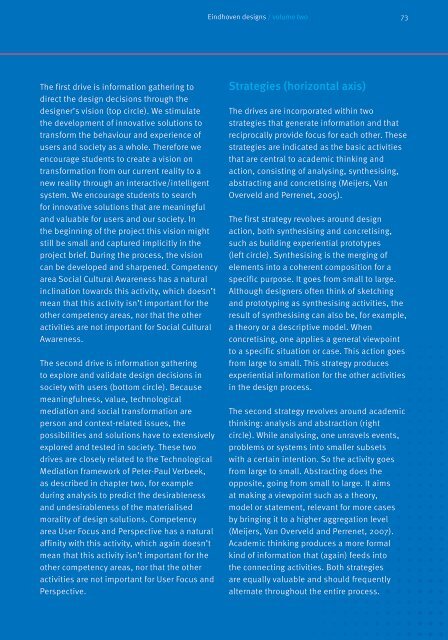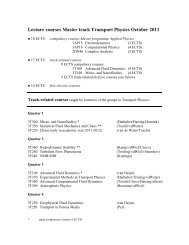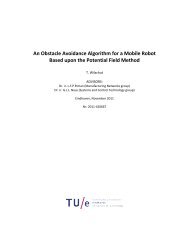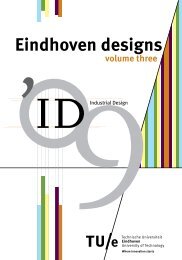Education guide 'Eindhoven designs' - Technische Universiteit ...
Education guide 'Eindhoven designs' - Technische Universiteit ...
Education guide 'Eindhoven designs' - Technische Universiteit ...
Create successful ePaper yourself
Turn your PDF publications into a flip-book with our unique Google optimized e-Paper software.
Eindhoven designs / volume two<br />
73<br />
The first drive is information gathering to<br />
direct the design decisions through the<br />
designer’s vision (top circle). We stimulate<br />
the development of innovative solutions to<br />
transform the behaviour and experience of<br />
users and society as a whole. Therefore we<br />
encourage students to create a vision on<br />
transformation from our current reality to a<br />
new reality through an interactive/intelligent<br />
system. We encourage students to search<br />
for innovative solutions that are meaningful<br />
and valuable for users and our society. In<br />
the beginning of the project this vision might<br />
still be small and captured implicitly in the<br />
project brief. During the process, the vision<br />
can be developed and sharpened. Competency<br />
area Social Cultural Awareness has a natural<br />
inclination towards this activity, which doesn’t<br />
mean that this activity isn’t important for the<br />
other competency areas, nor that the other<br />
activities are not important for Social Cultural<br />
Awareness.<br />
The second drive is information gathering<br />
to explore and validate design decisions in<br />
society with users (bottom circle). Because<br />
meaningfulness, value, technological<br />
mediation and social transformation are<br />
person and context-related issues, the<br />
possibilities and solutions have to extensively<br />
explored and tested in society. These two<br />
drives are closely related to the Technological<br />
Mediation framework of Peter-Paul Verbeek,<br />
as described in chapter two, for example<br />
during analysis to predict the desirableness<br />
and undesirableness of the materialised<br />
morality of design solutions. Competency<br />
area User Focus and Perspective has a natural<br />
affinity with this activity, which again doesn’t<br />
mean that this activity isn’t important for the<br />
other competency areas, nor that the other<br />
activities are not important for User Focus and<br />
Perspective.<br />
Strategies (horizontal axis)<br />
The drives are incorporated within two<br />
strategies that generate information and that<br />
reciprocally provide focus for each other. These<br />
strategies are indicated as the basic activities<br />
that are central to academic thinking and<br />
action, consisting of analysing, synthesising,<br />
abstracting and concretising (Meijers, Van<br />
Overveld and Perrenet, 2005).<br />
The first strategy revolves around design<br />
action, both synthesising and concretising,<br />
such as building experiential prototypes<br />
(left circle). Synthesising is the merging of<br />
elements into a coherent composition for a<br />
specific purpose. It goes from small to large.<br />
Although designers often think of sketching<br />
and prototyping as synthesising activities, the<br />
result of synthesising can also be, for example,<br />
a theory or a descriptive model. When<br />
concretising, one applies a general viewpoint<br />
to a specific situation or case. This action goes<br />
from large to small. This strategy produces<br />
experiential information for the other activities<br />
in the design process.<br />
The second strategy revolves around academic<br />
thinking: analysis and abstraction (right<br />
circle). While analysing, one unravels events,<br />
problems or systems into smaller subsets<br />
with a certain intention. So the activity goes<br />
from large to small. Abstracting does the<br />
opposite, going from small to large. It aims<br />
at making a viewpoint such as a theory,<br />
model or statement, relevant for more cases<br />
by bringing it to a higher aggregation level<br />
(Meijers, Van Overveld and Perrenet, 2007).<br />
Academic thinking produces a more formal<br />
kind of information that (again) feeds into<br />
the connecting activities. Both strategies<br />
are equally valuable and should frequently<br />
alternate throughout the entire process.

















